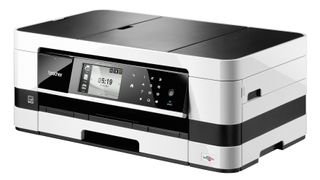How to buy the right Multi Functional Device for your print needs
Save money and improve your efficiency

Research carried out by AIM (Association for Information and Image Management) revealed that 77% of invoices that arrive as PDF attachments get printed, with 20% of organizations scanning half or more of their inbound mail.
Moving original paper documents to digital formats for archiving is also important across the business community, as is the ability to capture and share information that may be in printed form.
As the paperless office has failed to materialise, businesses must ensure they can manage their printing needs with advanced digital reproduction, to deliver an efficient workflow. As The Myth of the Paperless Office states: "We are not headed towards offices that use less paper but rather towards offices that keep less paper."
To enable this marriage of paper and digital, the MFD (Multi Functional Device) has become indispensable.
The development of MFDs has moved the technology on in leaps and bounds to deliver a device that can become a central service around which an office can orbit. With print and scanning capability now available over wireless networks, MFDs offer high-quality output within form factors that have continued to shrink in size and price.
Says Andrew Hall, Marketing Manager at Oki Systems (UK): "Choose a model that can scan both sides of a double-sided document. An MFD should save space, increase business efficiency and save power, but also check the sleep mode power saving is less than two watts, as the device will spend long periods asleep."
Dan Wogan, Print Business Manager at Micro-P also commented: "The latest ranges of business inkjet MFDs offer all the features and connectivity of their laser counterparts. Print quality and longevity using pigment inks have added the durability and speed for true business usability.
Are you a pro? Subscribe to our newsletter
Sign up to the TechRadar Pro newsletter to get all the top news, opinion, features and guidance your business needs to succeed!
"The latest developments in this field are the introduction of fixed, full-page-width print heads in office machines from the likes of Brother and HP, allowing a step change in the printing speed and further durability from non-moving parts. We're talking 70-100 pages per minute possible now."
The print, scan, copy and fax combination also means more communication and integration across a business.
With high-capacity wireless networks becoming commonplace, MFDs are increasingly using the cloud as a communications medium. Indeed, the new C2665dnf MFD from Dell offers a small footprint and NFC (Near Field Communication), printing via what the company calls "Tap and Print" - connecting mobile devices to a cloud-based document hub that delivers even more flexibility to users of the MFD.
"One of the biggest trends we see in the MFD market is the move towards connectivity," said Anil Jagpal, European Marketing Manager, Canon Europe. "Customers are increasingly demanding office technology to manage their documents from paper to digital and back again, through a variety of mobile and web-connected devices.
"MFDs, therefore, need to provide essential connectivity features such as Wi-Fi, Apple AirPrint, Google Cloud Print or a dedicated mobile printing app. These features can create a more flexible and productive working environment and guarantee easy printing within small office environments and busy workgroups."
One area that is often overlooked is the security of MFDs that may be used for scanning, copying and faxing highly sensitive documents.
Here, the use of the MFD should be covered within the wider security policies of the business. MFDs can be secured in a number of ways, including the use of PIN numbers to access the machine. If the machine is available on a network, a static IP address should be used for the MFD, with the machine having limited access behind the company firewall. The use of USB memory sticks can also be restricted to reduce the likelihood of sensitive data being lost or stolen.
Checklist
To ensure your MFD meets the needs of your business, follow this checklist:
1. Can the machine your business is considering handle the capacity needed?
MFDs come in all shapes and sizes. Many are aimed at the domestic market. Look closely at the stated capacity and match this to your business' workload.
2. How important is quality of scanning and printing?
Many of the latest MFDs using print technology that was, up until a short time ago, only found in high-end laser printers. Look at samples of print and scanned output before making your choice.
3. Is fax capability needed?
Fax is far from a dead communications medium, with many large businesses still needing it. Look at the fax capability of the MFD, which today is likely to use the cloud as well as direct dial to another fax machine.
4. Will your company need to manage sensitive information?
Access to the features of an MFD should be controlled with PIN numbers or passwords. Also, ensure that the MFD only prints the required copies to ensure data security. And think about whether the USB port should be disabled.
5. Does your business require remote printing?
With the rise of BYOD (Bring Your Own Device), printing from mobile devices is fast and efficient. Look closely at the apps that will use the MFD to ensure these connect securely.
An MFD can be a cost-effective asset that a business can build its workflow around. With MFDs now coming with a number of configurations, it's critical to asses your business' needs and match them to the right MFD.
